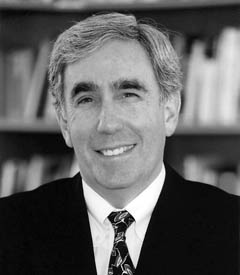Nuclear Age Peace Foundation Pamphleteering at Non-Proliferation Conference
Urging Giant Steps
David Krieger, president of the Santa Barbara-based Nuclear Age Peace Foundation, is doing everything he can to halt and reverse the increase in nuclear weaponry. Most recently, he has produced a pamphlet that will be distributed to members of the Obama administration and the U.S. Congress, as well as to all ambassadors arriving for a major international non-proliferation conference to take place in New York City next month.
One hundred eighty-nine countries are party to the Non-Proliferation Treaty. The participating countries meet once every five years for a Non-Proliferation Treaty Review Conference. The last such meeting, in 2005, was “a major failure,” according to Krieger, and he hopes that his pamphlet will help to make the 2010 conference more productive. It is titled “Nuclear Non-Proliferation and Disarmament: Shifting the Mindset—A Briefing Booklet for the 2010 Non-Proliferation Treaty Review Conference.”
In 2000, the conference was successful, according to Krieger, because it created 13 practical steps for disarmament. Unfortunately, five years later, none of these steps had been implemented.

And while participants in past conferences have agreed on taking small steps toward achieving disarmament, Krieger hopes that this conference will be far more ambitious. Krieger favors not only stricter international controls on nuclear weaponry, but its complete abolishment. Only a few countries produce nuclear weapons, he said. But they put all of humanity in danger of extinction.
The number of nuclear weapons existing today is 23,000, according to the NAPF. Of these, 95 percent are in Russia and the United States. Detonation of a nuclear weapon about 10 times the size of the bomb dropped on Hiroshima at the end of WWII would result in grave environmental consequences, writes Krieger, including the deterioration of complex forms of life and “nuclear starvation” resulting in the death of up to one billion people. (“Even the world’s oceans, the common heritage of humankind,” he lamented, “are home to nuclear weapons carried on submarines.”) Krieger deems any nation wishing to join in the support of nuclear weapons “insane.”
The problem will only be solved by “large numbers of people awakening to the threat,” he said. “We started the foundation in order to educate and advocate for a world without nuclear weapons.” Now in its 28th year, the Nuclear Age Peace Foundation is very connected to the Santa Barbara community. Many students from both Santa Barbara City College and UCSB work as interns for the NAPF, and the board of directors consists primarily of Santa Barbara residents. Its current chair is Richard Faulk, a Princeton University professor emeritus of international law and policy, currently teaching global studies at UCSB.
Krieger’s pamphlet highlights the differing perspectives concerning nuclear arms: from nuclear believers to the nuclear disempowered to the nuclear abolitionists. In it, he asserts that a thermonuclear war could result in omnicide, or the complete destruction of all life. He stresses that the most important strategy for abolitionists is to educate the public, rather than allowing the information to be concealed in complicated jargon reserved exclusively for the minds of experts and government officials.
In his speech in Prague on April 5, 2009, Obama said that although he supports nuclear disarmament, he realizes that the goal may not be achieved within his lifetime. A year later, on April 6, 2010, Obama’s administration released its Nuclear Posture Review, which is basically a policy statement on possession, threat, and potential use of nuclear weapons. On April 8, 2010, the president signed a nuclear arms reduction pact with Russia. While he praised Obama, Krieger also said, “Putting off the dilemma so far in the future,” that is, not in our lifetimes, “may be putting it off indefinitely.”
Krieger acknowledges the difficult road ahead in the conclusion of his pamphlet. According to Krieger, the disarmament of these weapons would “require us to try to solve our problems through diplomacy and peaceful means rather than resorting to war”.


